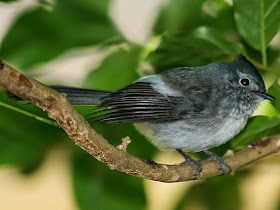Terenotriccus erythrurus
 |
| Photo by Anselmo d'Affonseca (Internet Bird Collection) |
Common name:
ruddy-tailed flycatcher (en); papa-moscas-uirapuru (pt); moucherolle rougequeue (fr); mosquerito colirrufo (es); rotschwanztyrann (de)
Taxonomy:
Order Passeriformes
Family Tyrannidae
Range:
This species is found from southernmost Mexico, Guatemala and Belize south to central Bolivia and brazil down to Mato Grosso, Tocantins and Maranhão.
Size:
These tiny flycatchers are 9-10 cm long and weigh 7 g.
Habitat:
The ruddy-tailed flycatcher is mostly found in moist tropical forests and swamp forests, often favouring forest clearings. They also use dry tropical forests and tall second growths. They are present from sea level up to an altitude of 1.200 m.
Diet:
They eat insects, particularly leafhoppers, either picking them from the foliage or hunting on the wing.
Breeding:
Ruddy-tailed flycatchers nests on a pear-shaped pouch of plant fibres and leaves with a side entrance, built by the female 2–6 m above the ground in the undergrowth of the forest and suspended from a twig or vine. The female lays 2 white eggs with chocolate-brown blotches, which she incubates alone for 15-22 days. The chicks are raised by the female alone and fledge about 19 days after hatching.
Conservation:
IUCN status - LC (Least Concern)
This species has a very large breeding range and a global population estimated at 500.000-5.000.000 indivduals. The ruddy-tailed flycatcher is suspected to lose 15-17% of suitable habitat within its distribution over the next decade based on a model of Amazonian deforestation. It is therefore suspected to suffer a small decline in the near future.


















